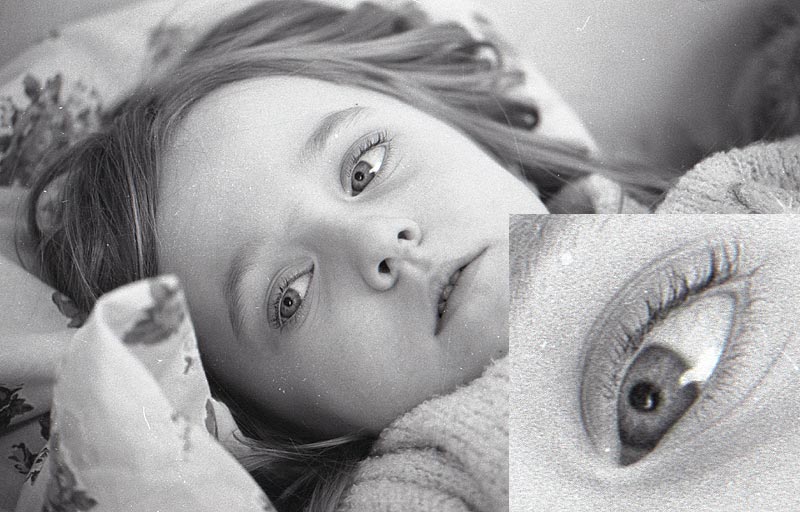Qow, so many answers.
🙂 I hope i didn't step on anyones toes with the first post I made. If I did I apologize, I was just very frustrated.
Anyway, I have just spent a good amount of time doing 26 different scans of the same thing which I will now explain here. It's going to be a fairly long post I would imagine
First of all, the scan is made from Ilford Delta 400 film. The film strip is more or less flat, but not as flat as it would be squeezed between two pieces of glass. But I doubt it can get any flatter in the stock holder.
Also, I have included dust and specks in the scans for the very reason that my focus on the subject might very well be off slightly. Anyway the dust and grain is the closest we have to an absolute value here as it's what we're in fact scanning. So I've based my conclusions mainly on looking at the dust and grain when comparing scans.
I used Epson Scan, and I turned everything off, so this is without any sharpening at all, no exposure adjustments, no post processing etc.
What I did first of all was put the film in the stock holder as advised by Epson - emulsion up. This created a very slight bend towards the glass of the scanner. And I mean very slight.
After that I did a partial scan of a frame, first at 600dpi, then at 800, 1200, 1600, 2000, 2400, 3200 and 4000dpi. The reason I did that was to try to get a grasp on how high I could go before it started to look like sharpness was breaking up and no more detail would appear.
Based on those scans I concluded that to my eye, out of the scans I did, it became better and better up until 1600dpi, then it started to turn to **** again. However, at 2000, 2400 and 3200 I noticed something I hadn't noticed before:
The below scan is a 100% view of both the 1600dpi and the 2400dpi scan in Aperture. If you look closely you can see how the edge of the leaves look pixelated. Kind of like a bad interpolation from 1600 -> 2400dpi. (2400dpi on top, 1600dpi bottom)
To me though, it became more interesting as I moved on to 3200dpi. At this stage, the pixelation is gone, and the edge looks smooth again. It doesn't have more detail, but it's smoother. In a way, it kind of makes sense to me, because 1600 * 2 == 3200 so it would be easier to do a software interpolation from 1600 -> 3200dpi. This leads me to further believe that the actual resolution of the scanner is somewhere around those 1600dpi, maybe even less. (3200dpi on top, 2400dpi bottom)

So at this stage I had concluded that the scans looks best to my eye at 1600dpi. I'm sure several people does not agree with me here, but that is what it looks like to me, so based on that I continued testing. I did the same tests going from 800 to 4000 dpi with the emulsion down, making the film bend ever so slightly away from the scanner glass. Amongst that set of scans I still saw the 1600dpi scan to be the best, but they we're all SLIGHTLY worse looking than the emulsion up scans (we're talking so slight difference here that it might be psychological). (emulsion down on top, emulsion up bottom):
This then led me to believe that I might get better results closer to the scanner glass than the stock holder would allow the film to sit. So I took the film strip out of the holder, put it directly on the glass and put the holder on top of it instead to try to get some sort of push towards the glass (even that the stock holder didn't seem to work for
😉). I had the emulsion towards the glass, so I got a very slight bend upwards.
Then I turned it over and got a slight bend towards the glass, of curse the film was touching the glass now. Here's a comparison between holder with emulsion up vs directly on glass with emulsion up - the difference, if any, is very small. I still favor the scan directly off the glass though: (glass in top, holder in bottom)
So, so far my conclusion is that I get better results directly on the glass and that the scanner only interpolates anything above 1600dpi. This might not be news to some. However, I still think the quality of the scans are lacking. Maybe I am expecting to much.
But let's play with the following thought:
Lets say the scanner does in fact only produce usable data up to 1600dpi.
Then lets say that 1600dpi is about 63dots/mm (a little less actually).
Then lets say a film frame is 36x24mm.
So at 1600dpi I'd get about 2248x1512 pixels
That is about 3,42mp worth of data.
So my Leica M6 with a Carl Zeiss C Biogon 35/2.8 in fact acts as a 3,42mp digital camera. Yay! That is in fact ridiculous.
I will do a test where I will take my 5Dmkii and my L macro lens and just take a digital shot of the negative. Right now I'm pretty confident it will come out a lot better. But who knows.
🙂
All of my scans are available here as a zip if anyone cares to sift through them all:
https://dl.dropbox.com/u/436484/v500/scans.zip












